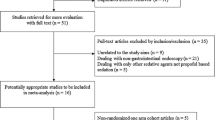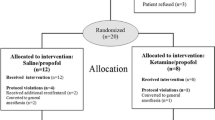Abstract
Bispectral index monitoring (BIS) is a quantitative assessment of brain cortical activity. The aim of this study was to determine if BIS-guided nurse-administered propofol sedation would decrease by ≥20% both recovery time and propofol dose compared to standard propofol sedation for endoscopic ultrasound (EUS). Prospectively, eligible outpatients were randomized to BIS-guided or standard propofol sedation during EUS. Propofol was given by nurses in intermittent boluses with sedation targeted at a BIS score of <65–75. For the control group, the nurse was blinded to BIS scores and sedation was titrated to a modified observer’s assessment of alertness/sedation scale (MOAA/S) score ≤3. Of 50 patients enrolled, data for 44 randomized to BIS-guidance (n = 24) and the control group (n = 20) were evaluated. Between the BIS-guided and control group there was no difference between the mean procedure duration, total propofol dose, recovery time, mean intraoperative MOAA/S, and mean BIS score. Compared to standard propofol sedation for EUS, BIS-guided propofol sedation offers no significant decrease in postprocedure recovery times or propofol doses.


Similar content being viewed by others
References
Rex DK, Overley C, Kinser K, Coates M, Lee A, Goodwine BW, Strahl E, Lemler S, Sipe B, Rahmani E, Helper D (2002) Safety of propofol administered by registered nurses with gastroenterologist supervision in 2000 endoscopic cases. Am J Gastroenterol 97:1159–1163
Vargo JJ, Zuccaro G Jr, Dumot JA, Shay SS, Conwell DL, Morrow JB (2000) Gastroenterologist-administered propofol for therapeutic upper endoscopy with graphic assessment of respiratory activity: a case series. Gastrointest Endosc 52:250–255
Kulling D, Rothenbuhler R, Inauen W (2003) Safety of nonanesthetist sedation with propofol for outpatient colonoscopy and esophagogastroduodenoscopy. Endoscopy 35:679–682
Khanna S, Tobin R, Khare S, Vij J, Kumar A (2003) Propofol-a safe and effective sedative for endoscopy. Indian J Gastroenterol 22:56–58
Hansen JJ, Ulmer BJ, Rex DK (2004) Technical performance of colonoscopy in patients sedated with nurse-administered propofol. Am J Gastroenterol 99:52–56
Walker JA, McIntyre RD, Schleinitz PF, Jacobson KN, Haulk AA, Adesman P, Tolleson S, Parent R, Donnelly R, Rex DK (2003) Nurse-administered propofol sedation without anesthesia specialists in 9152 endoscopic cases in an ambulatory surgery center. Am J Gastroenterol 98:1744–1750
Heuss LT, Schnieper P, Drewe J, Pflimlin E, Beglinger C (2003) Risk stratification and safe administration of propofol by registered nurses supervised by the gastroenterologist: a prospective observational study of more than 2000 cases. Gastrointest Endosc 57:664–671
Cohen LB, Dubovsky AN, Aisenberg J, Miller KM (2003) Propofol for endoscopic sedation: a protocol for safe and effective administration by the gastroenterologist. Gastrointest Endosc 58:725–732
Chen SC, Rex DK (2004) Review article: registered nurse-administered propofol sedation for endoscopy. Aliment Pharmacol Ther 19:147–155
Heuss LT, Schnieper P, Drewe J, Pflimlin E, Beglinger C (2003) Conscious sedation with propofol in elderly patients: a prospective evaluation. Aliment Pharmacol Ther 17:1493–1501
Reimann FM, Samson U, Derad I, Fuchs M, Schiefer B, Stange EF (2000) Synergistic sedation with low-dose midazolam and propofol for colonoscopies. Endoscopy 32:239–244
Rex DK, Heuss LT, Walker JA, Qi R (2005) Trained registered nurses/endoscopy teams can administer propofol safely for endoscopy. Gastroenterology 129:1384–1391
Ulmer BJ, Hansen JJ, Overley CA, Symms MR, Chadalawada V, Liangpunsakul S, Strahl E, Mendel AM, Rex DK (2003) Propofol versus midazolam/fentanyl for outpatient colonoscopy: administration by nurses supervised by endoscopists. Clin Gastroenterol Hepatol 1:425–432
Koshy G, Nair S, Norkus EP, Hertan HI, Pitchumoni CS (2000) Propofol versus midazolam and meperidine for conscious sedation in GI endoscopy. Am J Gastroenterol 95:1476–1479
Sipe BW, Rex DK, Latinovich D, Overley C, Kinser K, Bratcher L, Kareken D (2002) Propofol versus midazolam/meperidine for outpatient colonoscopy: administration by nurses supervised by endoscopists. Gastrointest Endosc 55:815–825
Weston BR, Chadalawada V, Chalasani N, Kwo P, Overley CA, Symms M, Strahl E, Rex DK (2003) Nurse-administered propofol versus midazolam and meperidine for upper endoscopy in cirrhotic patients. Am J Gastroenterol 98:2440–2447
Vargo JJ, Zuccaro G Jr, Dumot JA, Shermock KM, Morrow JB, Conwell DL, Trolli PA, Maurer WG (2002) Gastroenterologist-administered propofol versus meperidine and midazolam for advanced upper endoscopy: a prospective, randomized trial. Gastroenterology 123:8–16
Yusoff IF, Raymond G, Sahai AV (2004) Endoscopist administered propofol for upper-GI EUS is safe and effective: a prospective study in 500 patients. Gastrointest Endosc 60:356–360
Gillham MJ, Hutchinson RC, Carter R, Kenny GN (2001) Patient-maintained sedation for ERCP with a target-controlled infusion of propofol: a pilot study. Gastrointest Endosc 54:14–17
Wehrmann T, Kokabpick S, Lembcke B, Caspary WF, Seifert H (1999) Efficacy and safety of intravenous propofol sedation during routine ERCP: a prospective, controlled study. Gastrointest Endosc 49:677–683
Jung M, Hofmann C, Kiesslich R, Brackertz A (2000) Improved sedation in diagnostic and therapeutic ERCP: propofol is an alternative to midazolam. Endoscopy 32:233–288
Seifert H, Schmitt TH, Gültekin T, Caspary WF, Wehrmann T (2000) Sedation with propofol plus midazolam versus propofol alone for interventional endoscopic procedures: a prospective, randomized study. Aliment Pharmacol Ther 14:1207–1214
Krugliak P, Ziff B, Rusabrov Y, Rosenthal A, Fich A, Gurman GM (2000) Propofol versus midazolam for conscious sedation guided by processed EEG during endoscopic retrograde cholangiopancreatography: a prospective, randomized, double-blind study. Endoscopy 32:677–682
Fanti L, Agostoni M, Casati A, Guslandi M, Giollo P, Torri G, Testoni PA (2004) Target-controlled propofol infusion during monitored anesthesia in patients undergoing ERCP. Gastrointest Endosc 60:361–366
Chen WX, Lin HJ, Zhang WF, Gu Q, Zhong XQ, Yu CH, Li YM, Gu ZY (2005) Sedation and safety of propofol for therapeutic endoscopic retrograde cholangiopancreatography. Hepatobiliary Pancreat Dis Int 4:437–440
Riphaus A, Stergiou N, Wehrmann T (2005) Sedation with propofol for routine ERCP in high-risk octogenarians: a randomized, controlled study. Am J Gastroenterol 100:1957–1963
Agostoni M, Fanti L, Arcidiacono PG, Gemma M, Strini G, Torri G, Testoni PA (2007) Target-controlled infusion during monitored anesthesia care in patients undergoing EUS: propofol alone versus midazolam plus propofol. A prospective double-blind randomised controlled trial. Dig Liver Dis 39:81–86
Vargo JJ, Zuccaro G Jr, Dumot JA, Conwell DL, Morrow JB, Shay SS (2002) Automated graphic assessment of respiratory activity is superior to pulse oximetry and visual assessment for the detection of early respiratory depression during therapeutic upper endoscopy. Gastrointest Endosc 55:826–831
Kearse LA Jr, Rosow C, Zaslavsky A, Connors P, Dershwitz M, Denman W (1997) Bispectral analysis measures sedation and memory effects of propofol, midazolam, isoflurane, and alfentanil in healthy volunteers. Anesthesiology 86:836–847
Liu J, Singh H, White PF (1996) Electroencephalogram bispectral analysis predicts the depth of midazolam-induced sedation. Anesthesiology 84:64–69
O’Connor MF, Daves SM, Tung A, Cook RI, Thisted R, Apfelbaum J (2001) BIS monitoring to prevent awareness during general anesthesia. Anesthesiology 94:520–522
Bower AL, Ripepi A, Dilger J, Boparai N, Brody FJ, Ponsky JL (2000) Bispectral index monitoring of sedation during endoscopy. Gastrointest Endosc 52:192–196
Wehrmann T, Grotkamp J, Stergiou N, Riphaus A, Kluge A, Lembcke B, Schultz A (2002) Electroencephalogram monitoring facilitates sedation with propofol for routine ERCP: a randomized, controlled trial. Gastrointest Endosc 56:817–824
Chen SC, Rex DK (2004) An initial investigation of bispectral monitoring as an adjunct to nurse-administered propofol sedation for colonoscopy. Am J Gastroenterol 99:1081–1086
Drake LM, Chen SC, Rex DK (2006) Efficacy of bispectral monitoring as an adjunct to nurse-administered propofol sedation for colonoscopy: a randomized controlled trial. Am J Gastroenterol 101:2003–2007
Bournet B, Migueres I, Delacroix M, Vigouroux D, Bornet JL, Escourrou J, Buscail L (2006) Early morbidity of endoscopic ultrasound: 13 years’ experience at a referral center. Endoscopy 38:349–354
Acknowledgements
This Grant was supported by Aspect Medical Systems, Inc., Norwood, MA.
Author information
Authors and Affiliations
Corresponding author
Rights and permissions
About this article
Cite this article
DeWitt, J.M. Bispectral Index Monitoring for Nurse-Administered Propofol Sedation During Upper Endoscopic Ultrasound: A Prospective, Randomized Controlled Trial. Dig Dis Sci 53, 2739–2745 (2008). https://doi.org/10.1007/s10620-008-0198-x
Received:
Accepted:
Published:
Issue Date:
DOI: https://doi.org/10.1007/s10620-008-0198-x




